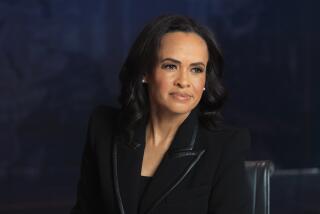TV NEWS RISE, FALL IS TIED TO ANCHORS
- Share via
SAN DIEGO — Television news directors know the importance of “anchor people,” the men or women who sit behind a desk and read the news with empathy, feeling, sparkle, pizazz, or, they hope, a charismatic hodgepodge of everything human they can beam at a camera.
When a popular anchor leaves, TV news directors have been known, in the words of one, to “flip out.”
Paul Sands, news director at KGTV (Channel 10)--the city’s No. 1-rated news station at 11 p.m.--isn’t flipping out. But he isn’t thrilled.
“ Don’t remind me about it!” he said, waving his arms in mock disgust. “Look at me, tears running down my cheeks, all hope is lost. And now you bring it up.”
“It” is the recently announced departure of Bree Walker, who co-anchors Channel 10’s 11 p.m. newscast with Carol LeBeau. Walker said yes to a big career move--she’s going to WCBS-TV in New York.
“Bree has been a major part of our success at 11 o’clock,” Sands said, immediately forecasting that her departure wouldn’t kill the newscast. He went on to credit LeBeau, “Michael Tuck’s Perspective” and a few dozen cameramen and support people with helping make the No. 1 mark the reality it is.
Make no mistake, however. He would rather she stayed.
“Anchors,” he said, “are extremely important. Every study I’ve ever seen indicates that people watch the news largely out of loyalty to who’s bringing it to them. They want to hear the news--unsettling though it might be--delivered by people they like. It’s part of the psychology of television.”
It is also true that some people consider television--particularly local news--superficial, shallow, unchallenging, unjournalistic. Sands, 40, at his current job since 1984, is a TV veteran, having worked as a news director, producer or writer for stations in Seattle, St. Louis and Portland, Ore. He bristles at those “unfair stereotypes.”
“You hear that anchors are the Ken and Barbie dolls of TV,” he said. “You hear jokes about hair spray, the sweaters they wear. Some of that’s true in L.A.
“Up there, anchors just dab on a little makeup and smile at the camera. News in San Diego is as good or better than anything I’ve seen from Los Angeles. And here, at KGTV, it just isn’t a cosmetic, show-biz operation. It’s hard news, gathered honorably.”
But like his counterparts at channels 8 and 39, Sands has no reservations about taking a “freebie” or “junket”--journalistic favors or trips paid for by someone else. Reporter Bob Donley recently filed stories from Israel, Egypt and Hungary.
Such trips are part of local television’s increasing use of travel as a way to whet viewers’ appetites, but, Sands concedes, the expense for such trips is often shared with a major airline whose contribution is noted. Such was the case with Donley’s stories.
“As long as you’re up front about it, as we are,” Sands said, “I don’t see anything wrong with it.”
Channel 10 commentator Michael Tuck--who airs a nightly opinion piece--will soon travel to Texas to trace his family’s history. Sands was asked why such information would be compelling to viewers at large--in other words, to anyone besides Tuck’s family.
Part of it has to do with the sense of identification and empathy viewers have with anchors, Sands said, adding that other factors also figure in.
“People are fascinated with their own history,” Sands said. “In addition to Tuck finding his own background, he’ll go to the Salt Lake City genealogy library and tell others how to trace their roots.
“We’re a visual medium. We can’t just tell people--we have to show them.”
Like Ron Miller, his counterpart at Channel 39, Sands compares himself to a baseball manager. When he’s winning, as he is now--with a wide lead at 11 p.m., a close second at 5 p.m.--he’s considered “a champ.” When a news director begins to falter--or rather, his ratings drop--he is perceived as a loser, and the station, Sands said, “usually starts looking around” for a replacement.
Sands, a diminutive, intense man with a sharp, acerbic sense of humor, said he likes to compete. He has a bowling pin to prove it. Sands, who isn’t a bowler, said the pin--on a shelf in his office--symbolizes his successful attempt, while at a St. Louis station, to oust “an annoying lead-in show” that, once removed, dramatically boosted ratings for the newscast that followed. The show: “Bowling for Dollars.”
Hassling with lead-ins is just part of the job. He approves trips, hires and fires, oversees assignments, and generally “sets the tone” for the newscasts that the station airs.
“My philosophy can be summarized in one sentence,” he said. “Get there first and do it right.”
He said Channel 10 does more investigative work than San Diego’s other stations. He cited a Ted Dracos series on pollution in San Diego Bay.
“We got the ball rolling on cleaning up that thing,” Sands said.
His competitive sense came to the fore even in commenting on what--ostensibly--was a victory for Channel 39: Its live, staff-reported coverage of Dennis Conner’s America’s Cup victory in Australia. Using a free-lance correspondent, “and spending a lot less money,” Sands said Channel 10 still managed to beat 39.
Ron Miller, news director at 39, called Sands’ comment “ridiculous . . . hyperbole and rationalization.”
Sands said he would “stand by” his rating.
As for Bree Walker’s replacement?
“We’re conducting a nationwide search,” he said with a sigh.
More to Read
The complete guide to home viewing
Get Screen Gab for everything about the TV shows and streaming movies everyone’s talking about.
You may occasionally receive promotional content from the Los Angeles Times.






